biochemical and haematological profile - Universitatea de Ştiinţe ...
biochemical and haematological profile - Universitatea de Ştiinţe ...
biochemical and haematological profile - Universitatea de Ştiinţe ...
Create successful ePaper yourself
Turn your PDF publications into a flip-book with our unique Google optimized e-Paper software.
<strong>Universitatea</strong> <strong>de</strong> Științe Agricole și Medicină Veterinară Iași<br />
During the light period (at noon)<br />
The pinealocytes became smaller in size , polyhedral in shape <strong>and</strong> the cytoplasm became<br />
lighter in stain <strong>and</strong> non granular (Fig.9). The nuclei remain spherical, vesicular <strong>and</strong> eccentric<br />
with a prominent nucleolus. The blood vessels became smaller in caliper <strong>and</strong> not engorged<br />
with blood.<br />
The pinealocytes appeared more electron lucent, free from secretory granules <strong>and</strong> the nucleus<br />
became slightly irregular in outline. The <strong>profile</strong>s of the other organelles remained as the<br />
previous stage (Fig.10).<br />
By using the indirect immunohistochemical technique the pinealocytes showed a very faint or<br />
slight reaction to the antimelatonin antibodies (Fig.11).<br />
DISCUSSION<br />
The epiphysis cerebri has a very interesting histological structure based on its unique<br />
anatomical position. It is generally accepted that the pineal body <strong>de</strong>velop as an upward<br />
growth from the diencephalon to which it is connected by a short stalk (Ferreira‐Me<strong>de</strong>iros et<br />
al. 2007 <strong>and</strong> Borregon et al. 1997).<br />
The gl<strong>and</strong> un<strong>de</strong>r investigation was covered by a thin fibrous capsule, the pia matter, from<br />
which short septa penetrate the gl<strong>and</strong> as mentioned by Hafeez (2005); Kus et al. (2004) <strong>and</strong><br />
Reus et al. (1990). The parenchymatous elements of the gl<strong>and</strong> were supported by an extensive<br />
network of reticular fibers (Borregon et al. 1997). Besi<strong>de</strong> its role as a protective coat, the<br />
fibrous stroma carry blood vessels, lymph <strong>and</strong> nerve supply of the gl<strong>and</strong> (Kus etal. 2004).<br />
There is a general agreement that the histological picture of the pineal parenchyma differs<br />
according to light or dark period to which the individual exposed (Ferreira‐Me<strong>de</strong>iros et<br />
al.2007; Kus et al. 2004 <strong>and</strong> Matsushima et al 1990). The authors stated that the gl<strong>and</strong><br />
becomes well <strong>de</strong>veloped with a pronounced proliferation <strong>and</strong> activity of its parenchymal cells<br />
during dark period while during light, the activity of the gl<strong>and</strong> is greatly <strong>de</strong>creased. In this<br />
respect, our study revealed that the pinealocytes of the gl<strong>and</strong>s collected during dark period<br />
showed a marked proliferation as they become larger in size with finely granular cytoplasm<br />
together with a marked congestion of the pineal blood vessels. The above mentioned<br />
histological signs indicate a higher activity of the organ (Macchi <strong>and</strong> Bruce 2004). Moreover,<br />
the pinealocytes showed a well <strong>de</strong>veloped rough endoplasmic reticulum, Golgi complex as<br />
well as many mitochondria as mentioned by Ueck (1973) <strong>and</strong> Oksche et al. (1972). The authors<br />
explained the role of each of these organelles in the secretory activity of the cell. The presence<br />
of electron <strong>de</strong>nse secretory granules as well as lipid droplets in the cytoplasm of pinealocytes<br />
of buck at dark periods is an absolute sign of the increased secretory activity of the gl<strong>and</strong> as<br />
explained by Uria et al. (1992) <strong>and</strong> Owman <strong>and</strong> Ru<strong>de</strong>berg (1970). The pinealocytes of buck<br />
showed long <strong>and</strong> branched cytoplasmic processes which either terminate in a flat dilatation<br />
adjacent to blood capillaries or synapses with unmyelinated nerve. Similar observations were<br />
also reported by Reuss et al. (1990) <strong>and</strong> Oksche et al. (1972). The latter explained the role of<br />
cytoplasmic processes in the secretion on the other h<strong>and</strong> Mutsushima et al. (1990) explained<br />
them as stimuli receivers. Both opinions could be met in the buck pineal where the<br />
cytoplasmic processes joining blood capillaries play a role in secretion while that synapses with<br />
nerve act as stimuli receivers.<br />
The immunohistochemical reaction in our study augments the electron microscopic findings<br />
<strong>and</strong> indicates that the buck pinealocytes produce consi<strong>de</strong>rable amount of melatonin during<br />
darkness as stated by most researchers studying the pineal gl<strong>and</strong>. Alex<strong>and</strong>r (1970) <strong>and</strong> Moore<br />
et al. (1967) mentioned that the production of melatonin by the pineal gl<strong>and</strong> is stimulated by<br />
15



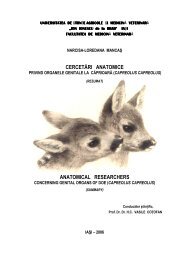
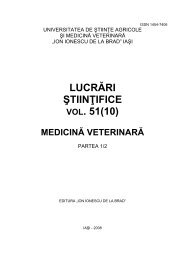

![rezumat teză [RO]](https://img.yumpu.com/19764796/1/190x245/rezumat-teza-ro.jpg?quality=85)
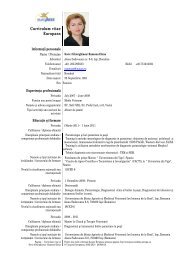



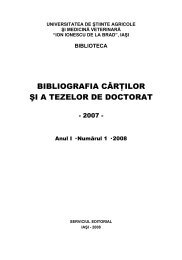
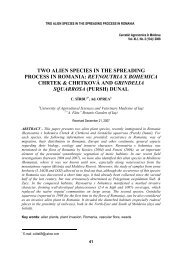
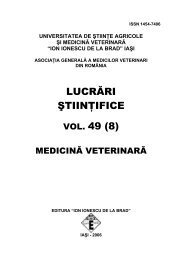
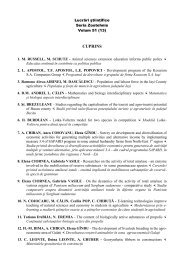
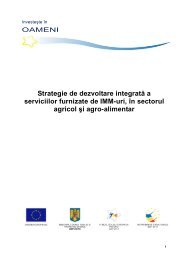
![rezumat teză [RO] - Ion Ionescu de la Brad](https://img.yumpu.com/14613555/1/184x260/rezumat-teza-ro-ion-ionescu-de-la-brad.jpg?quality=85)
